Fighting big saltwater gamefish is an exhilarating experience. It’s something all anglers strive for yet far too many are never exposed to the basics of fish fighting techniques needed to do it effectively. Understanding how to use rod, reel and line to pressure a big fish to the boat without putting unnecessary physical stress on yourself has to be learned, and once it’s explained it isn’t difficult in practice.
You’ve probably heard anglers recount stories of battling large fish, exclaiming how exhausting it was, how that fish, “Kicked my rear.” Here’s an example of how using tackle properly can make all the difference in the outcome.
On a trip to fish for bluefin tuna off the MidAtlantic coast a few years back, the anglers onboard included three young, brawny state troopers who had no prior experience with big, hard-fighting fish, and one older, considerably smaller angler who was experienced. Short standup rods, lever drag reels loaded with 50-pound test line and fighting belts and harnesses were the tools of the day. The honor of the first fish went to one of the troopers who made all the mistakes in the book and ended up exhausted in ten minutes while the tuna was still full of fight. He handed the rod off to one of his buddies with a look of disbelief on his face. His partner gave it a shot, lasting 15 minutes before his arms and back were aching. He passed it to the last of the group to finish the job. The fish was 60-pounds, certainly not too big for any one of those guys to handle if they knew how to use the gear properly and what to expect from the fish.
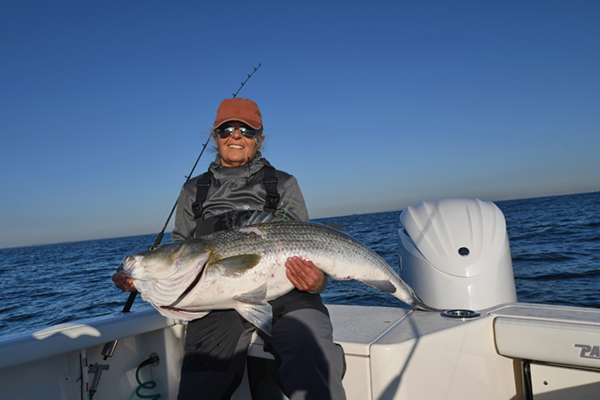
The second fish went to the experienced angler who was dwarfed by the three officers. He clipped the rod and reel into the belt and harness, placed his knees against the gunwale, made sure the drag was at the strike setting, leaned back in the harness with his right hand on the reel handle and the left resting atop the reel, and let the fish do its thing. While the tuna was screaming line off the reel against the drag on its initial run, he kept the rod tip low, just a little above horizon of the water, pointing in the direction of the fish. He was relaxed using his body weight to offset the drag pressure against the fish. As soon as the fish stopped running, he began a rhythmic pump and reel motion using his body weight to lift the rod tip two feet at a time, then he quickly turned the reel handle once or twice to regain line as he reeled the rod back into position for the next pump.
The experienced angler never raised the rod tip high, and he didn’t lift it using his back, arms and shoulders like the troopers did. He used his body weight in the harness to make modest pumps as he pulled the fish back toward him to gain line. When the fish started to run a second time, he leaned back into his relaxed position and pushed the drag lever up a notch, a sequence he repeated each time the fish made another run after stopping. Every time the fish took off, it had to work even harder against the increased drag pressure which tired it quickly and, some would say, broke its will to fight. His tuna was easily over 100 pounds, and it was boatside in half the time of the first, and without tiring himself out in the process. He used the tackle as intended, which made it possible for a smaller person to catch a larger fish in a shorter amount of time with minimal physical output, less strain, and no pain.
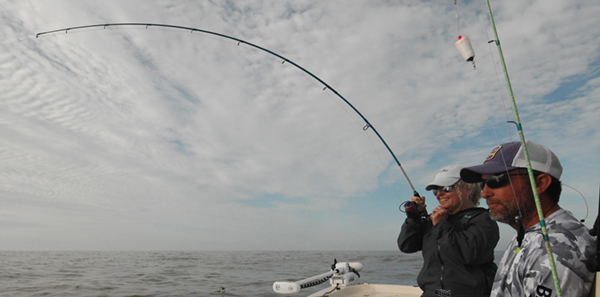
How can you apply these principles to almost any kind of fishing when a big fish is on the line? Here are some simple tips.
The drag on a reel is what tires a big fish and allows you to bring it in, so always set your drag pressure with a scale. With a lever drag reel you can set an initial strike drag which should be about one-third of the line’s rated pound test. You should also mark the reel with tape showing where additional heavier drag settings are positioned so you can add drag a little at a time after each run of a big fish. When the lever is pushed all the way up to the final stop—called full drag—the setting should be no more than three-fourths of the rated line test. Lever drag reels were designed for challenging gamefish like tuna, billfish, swordfish and wahoo, but smaller lever drag reels for inshore fishing have become very popular and give the angler the same benefit of multiple drag settings. Now this might surprise you, but when a fish is pulling line against drag, there is no difference in the amount of pressure whether the rod tip is raised high or if it is pointed directly at the fish. Far too many anglers believe the fallacy that holding the rod high increases the pressure on the fish.
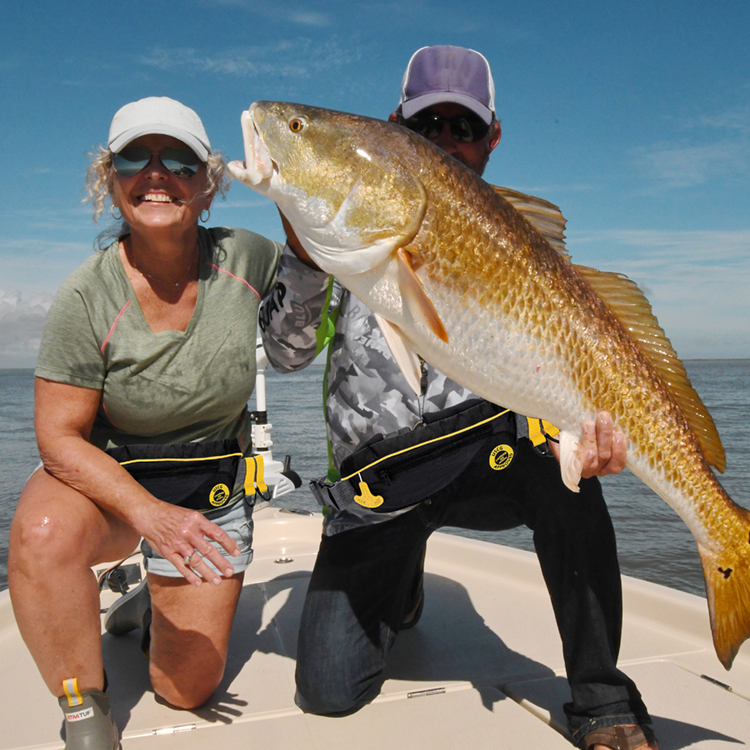
Jake Jordan, a long-time Yamaha pro captain who has caught thousands of tarpon, sailfish and marlin on fly tackle, recently demonstrated this for the Yamaha team. He used a drag scale and one of his big game fly outfits with a 20-pound test IGFA® legal leader system set up for fighting 100-pound plus tarpon from his skiff in Marathon, Florida. He hooked the scale to the end of the leader with the drag on the reel set at six pounds of pressure, and had another angler run away from him pulling line off the reel with the scale. The first time he held the rod tip high putting a deep bend in the rod. The scale read six pounds. He repeated the process with the rod tip pointed directly at the man pulling the line, then checked the scale again. Six pounds.
“The drag puts the same amount of pressure on the fish with the rod pointed straight at it as it did with me straining my back and arms to hold the rod tip high. The only thing I accomplished was putting unnecessary pressure on myself, not the fish. This holds true no matter what kind of tackle you are using. The drag pressure you set is the drag pressure the fish pulls against. The rod angle has no bearing on that pressure. Try it yourself the next time you’re hooked up and a big fish is making a run. Instead of holding the rod up at a high angle, lower it to a comfortable position with your arms straight and see how much strain it takes off you.”
A fishing rod serves two purposes. First, it’s your tool for casting. Second, it is a fish-fighting tool, but not in the way some think. When fighting a fish, especially a big fish, the rod is a lever and shock absorber between angler and fish. It is used to help pull the fish back to the boat when raised during the process of pumping and reeling, but when a fish is taking line against the drag the rod plays no role. When the fish stops running you regain line by lifting the rod tip to pull the fish closer to you, and you recapture that line by turning the reel handle as you drop the rod tip for the next pump.
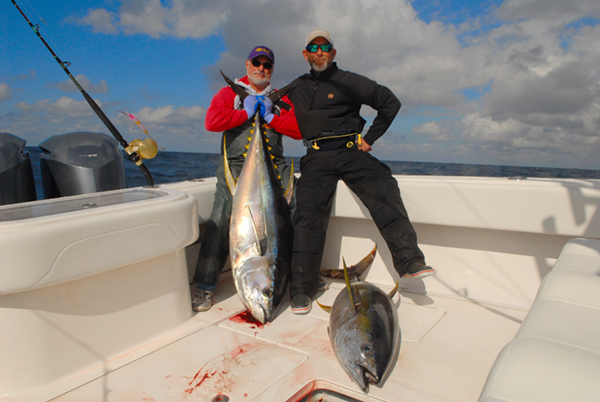
That leads us to another misconception. When pumping a big fish in, a lot of anglers lift the rod tip far too high. Once the rod is lifted to about two-thirds of the distance between horizontal and vertical you aren’t gaining any additional line, just bending the rod more deeply and it costs you additional energy for no gain. You are just putting more strain on yourself and potentially giving the fish a chance to escape if you drop the rod tip too quickly to reel in the line. That allows momentary slack line between you and the fish, which gives it a chance to throw the lure or hook when it turns or shakes its head. The rod also serves as a shock absorber which can prevent a fish that makes a sudden lunge, especially when it’s close to the boat, from breaking the line.
Now let’s put it all together into a fish fighting strategy. When you first hook up, keep the rod low so your arms are relatively straight and let the fish run against the drag. Don’t worry about long runs, your reel holds plenty of line. If being spooled becomes a concern, you have another fish-fighting tool at your disposal—the boat. You can always use it to chase the fish, but that should be done carefully. Running down a fish faster than the angler can pick up the line can cause slack, so be sure the person at the helm can see where the fish is going by watching your line and paces the boat to how fast you can reel. The boat can be back down on a fish in reverse, or in an open boat can be fought from the bow or admidship as the helmsman runs the boat forward.
Once the first run stops, do your best to keep the line between you and the fish moving. If the fish isn’t pulling drag, you’re pumping and retrieving line. Don’t let the fish rest, but you rest when the fish is taking line by lowering the rod to relieve unnecessary exertion. With a lever drag reel, increase the drag pressure a little after each run ends. You can also do this with spinning or star drag reels, but you must do so carefully since there are no markings to show exactly how much you have increased the resistance. If the fish turns and runs directly at you or angles toward you, crank as fast as you can to take advantage of the opportunity to gain free line. Experienced anglers say this strategy can break a big pelagic fish’s will to keep fighting, especially towards the end.
The endgame can vary with the species of fish you are targeting. With tuna, the finish line is signaled when the fish transitions into swimming in lazy circles under the boat. Sometimes those circles start a hundred feet down, at other times much shallower and it forces the angler to lift the fish vertically because it is directly below the boat. Plant yourself in a transom corner and keep your pumps short, steady and as fast as the fish will allow. With large tuna, you might gain and lose the last 100 feet of line a dozen or more times. It’s a give and take, but you can take advantage of the circling behavior if you know how. When the fish is circling away, try to relax and hold position, add some extra drag by placing your hand against the spool of the reel, and when it starts to come around toward the boat, pump and reel quickly to gain extra line. Identify the cadence and you can get an extra turn or two on the reel handle with each go round gaining hard-earned line with less effort.
For most other species, the endgame includes a lunge to escape when the fish sees the boat so be prepared for it. Remember you have that shock absorber in your hand. If the fish is alongside and still green (not tired out), you can back off on the drag a little and let it put some distance between itself and the boat. Then push the drag back up and continue the fight.
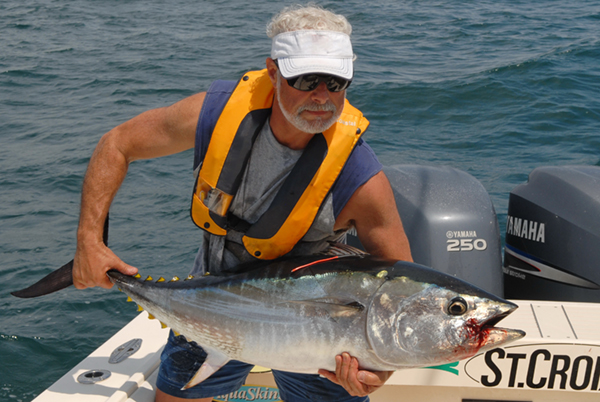
When a fish is subdued and boatside, you must decide whether you are going to harvest or release it. Almost all billfish, large and small, are released. Fish like tuna, swordfish, wahoo and mahi mahi destined for the dinner table are typically gaffed or subdued with a dart, then brought aboard with gaffs. Inshore species like big striped bass and redfish are strictly regulated using slot size limits, so the biggest fish are all released. That can be accomplished by netting them, bringing them on deck and removing the hook or unhooking them while still in the water. If a fish looks overly stressed, be sure to revive it for an ample amount of time so they can swim away to fight another day.
Fighting big fish is challenging, not so much for the physicality of the endeavor as for the technical aspect of having the right tackle and knowing how to use it to your advantage. Follow these tips and you can catch pretty much anything that swims.
Back to Blue Life
You’ve probably heard anglers recount stories of battling large fish, exclaiming how exhausting it was, how that fish, “Kicked my rear.” Here’s an example of how using tackle properly can make all the difference in the outcome.
On a trip to fish for bluefin tuna off the MidAtlantic coast a few years back, the anglers onboard included three young, brawny state troopers who had no prior experience with big, hard-fighting fish, and one older, considerably smaller angler who was experienced. Short standup rods, lever drag reels loaded with 50-pound test line and fighting belts and harnesses were the tools of the day. The honor of the first fish went to one of the troopers who made all the mistakes in the book and ended up exhausted in ten minutes while the tuna was still full of fight. He handed the rod off to one of his buddies with a look of disbelief on his face. His partner gave it a shot, lasting 15 minutes before his arms and back were aching. He passed it to the last of the group to finish the job. The fish was 60-pounds, certainly not too big for any one of those guys to handle if they knew how to use the gear properly and what to expect from the fish.

The second fish went to the experienced angler who was dwarfed by the three officers. He clipped the rod and reel into the belt and harness, placed his knees against the gunwale, made sure the drag was at the strike setting, leaned back in the harness with his right hand on the reel handle and the left resting atop the reel, and let the fish do its thing. While the tuna was screaming line off the reel against the drag on its initial run, he kept the rod tip low, just a little above horizon of the water, pointing in the direction of the fish. He was relaxed using his body weight to offset the drag pressure against the fish. As soon as the fish stopped running, he began a rhythmic pump and reel motion using his body weight to lift the rod tip two feet at a time, then he quickly turned the reel handle once or twice to regain line as he reeled the rod back into position for the next pump.
The experienced angler never raised the rod tip high, and he didn’t lift it using his back, arms and shoulders like the troopers did. He used his body weight in the harness to make modest pumps as he pulled the fish back toward him to gain line. When the fish started to run a second time, he leaned back into his relaxed position and pushed the drag lever up a notch, a sequence he repeated each time the fish made another run after stopping. Every time the fish took off, it had to work even harder against the increased drag pressure which tired it quickly and, some would say, broke its will to fight. His tuna was easily over 100 pounds, and it was boatside in half the time of the first, and without tiring himself out in the process. He used the tackle as intended, which made it possible for a smaller person to catch a larger fish in a shorter amount of time with minimal physical output, less strain, and no pain.

How can you apply these principles to almost any kind of fishing when a big fish is on the line? Here are some simple tips.
The drag on a reel is what tires a big fish and allows you to bring it in, so always set your drag pressure with a scale. With a lever drag reel you can set an initial strike drag which should be about one-third of the line’s rated pound test. You should also mark the reel with tape showing where additional heavier drag settings are positioned so you can add drag a little at a time after each run of a big fish. When the lever is pushed all the way up to the final stop—called full drag—the setting should be no more than three-fourths of the rated line test. Lever drag reels were designed for challenging gamefish like tuna, billfish, swordfish and wahoo, but smaller lever drag reels for inshore fishing have become very popular and give the angler the same benefit of multiple drag settings. Now this might surprise you, but when a fish is pulling line against drag, there is no difference in the amount of pressure whether the rod tip is raised high or if it is pointed directly at the fish. Far too many anglers believe the fallacy that holding the rod high increases the pressure on the fish.

Jake Jordan, a long-time Yamaha pro captain who has caught thousands of tarpon, sailfish and marlin on fly tackle, recently demonstrated this for the Yamaha team. He used a drag scale and one of his big game fly outfits with a 20-pound test IGFA® legal leader system set up for fighting 100-pound plus tarpon from his skiff in Marathon, Florida. He hooked the scale to the end of the leader with the drag on the reel set at six pounds of pressure, and had another angler run away from him pulling line off the reel with the scale. The first time he held the rod tip high putting a deep bend in the rod. The scale read six pounds. He repeated the process with the rod tip pointed directly at the man pulling the line, then checked the scale again. Six pounds.
“The drag puts the same amount of pressure on the fish with the rod pointed straight at it as it did with me straining my back and arms to hold the rod tip high. The only thing I accomplished was putting unnecessary pressure on myself, not the fish. This holds true no matter what kind of tackle you are using. The drag pressure you set is the drag pressure the fish pulls against. The rod angle has no bearing on that pressure. Try it yourself the next time you’re hooked up and a big fish is making a run. Instead of holding the rod up at a high angle, lower it to a comfortable position with your arms straight and see how much strain it takes off you.”
A fishing rod serves two purposes. First, it’s your tool for casting. Second, it is a fish-fighting tool, but not in the way some think. When fighting a fish, especially a big fish, the rod is a lever and shock absorber between angler and fish. It is used to help pull the fish back to the boat when raised during the process of pumping and reeling, but when a fish is taking line against the drag the rod plays no role. When the fish stops running you regain line by lifting the rod tip to pull the fish closer to you, and you recapture that line by turning the reel handle as you drop the rod tip for the next pump.

That leads us to another misconception. When pumping a big fish in, a lot of anglers lift the rod tip far too high. Once the rod is lifted to about two-thirds of the distance between horizontal and vertical you aren’t gaining any additional line, just bending the rod more deeply and it costs you additional energy for no gain. You are just putting more strain on yourself and potentially giving the fish a chance to escape if you drop the rod tip too quickly to reel in the line. That allows momentary slack line between you and the fish, which gives it a chance to throw the lure or hook when it turns or shakes its head. The rod also serves as a shock absorber which can prevent a fish that makes a sudden lunge, especially when it’s close to the boat, from breaking the line.
Now let’s put it all together into a fish fighting strategy. When you first hook up, keep the rod low so your arms are relatively straight and let the fish run against the drag. Don’t worry about long runs, your reel holds plenty of line. If being spooled becomes a concern, you have another fish-fighting tool at your disposal—the boat. You can always use it to chase the fish, but that should be done carefully. Running down a fish faster than the angler can pick up the line can cause slack, so be sure the person at the helm can see where the fish is going by watching your line and paces the boat to how fast you can reel. The boat can be back down on a fish in reverse, or in an open boat can be fought from the bow or admidship as the helmsman runs the boat forward.
Once the first run stops, do your best to keep the line between you and the fish moving. If the fish isn’t pulling drag, you’re pumping and retrieving line. Don’t let the fish rest, but you rest when the fish is taking line by lowering the rod to relieve unnecessary exertion. With a lever drag reel, increase the drag pressure a little after each run ends. You can also do this with spinning or star drag reels, but you must do so carefully since there are no markings to show exactly how much you have increased the resistance. If the fish turns and runs directly at you or angles toward you, crank as fast as you can to take advantage of the opportunity to gain free line. Experienced anglers say this strategy can break a big pelagic fish’s will to keep fighting, especially towards the end.
The endgame can vary with the species of fish you are targeting. With tuna, the finish line is signaled when the fish transitions into swimming in lazy circles under the boat. Sometimes those circles start a hundred feet down, at other times much shallower and it forces the angler to lift the fish vertically because it is directly below the boat. Plant yourself in a transom corner and keep your pumps short, steady and as fast as the fish will allow. With large tuna, you might gain and lose the last 100 feet of line a dozen or more times. It’s a give and take, but you can take advantage of the circling behavior if you know how. When the fish is circling away, try to relax and hold position, add some extra drag by placing your hand against the spool of the reel, and when it starts to come around toward the boat, pump and reel quickly to gain extra line. Identify the cadence and you can get an extra turn or two on the reel handle with each go round gaining hard-earned line with less effort.
For most other species, the endgame includes a lunge to escape when the fish sees the boat so be prepared for it. Remember you have that shock absorber in your hand. If the fish is alongside and still green (not tired out), you can back off on the drag a little and let it put some distance between itself and the boat. Then push the drag back up and continue the fight.

When a fish is subdued and boatside, you must decide whether you are going to harvest or release it. Almost all billfish, large and small, are released. Fish like tuna, swordfish, wahoo and mahi mahi destined for the dinner table are typically gaffed or subdued with a dart, then brought aboard with gaffs. Inshore species like big striped bass and redfish are strictly regulated using slot size limits, so the biggest fish are all released. That can be accomplished by netting them, bringing them on deck and removing the hook or unhooking them while still in the water. If a fish looks overly stressed, be sure to revive it for an ample amount of time so they can swim away to fight another day.
Fighting big fish is challenging, not so much for the physicality of the endeavor as for the technical aspect of having the right tackle and knowing how to use it to your advantage. Follow these tips and you can catch pretty much anything that swims.
Back to Blue Life
